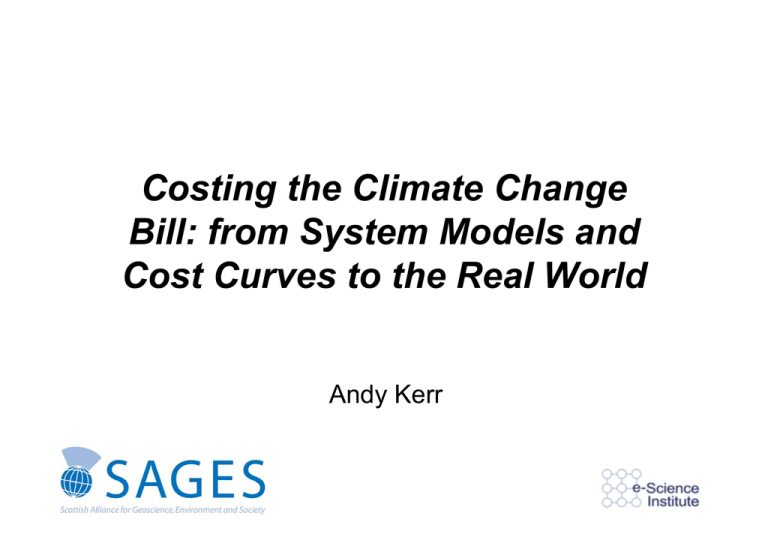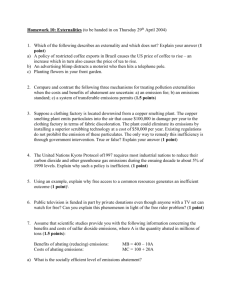Costing the Climate Change Bill: from System Models and Andy Kerr
advertisement

Costing the Climate Change Bill: from System Models and Cost Curves to the Real World Andy Kerr What this means by sector: 34% & 42% Change needed from 2006 to 2020 - 42% 2006 emissions MtCO2e MtCO2e MtCO2e % MtCO2e % 23.0 -5.2 -23% -9.0 -39% 2.0 -0.2 -9% -0.2 -9% 3.6 +0.5 +14% +0.5 +14% -3.9 -42% -4.3 -46% -3.4 -24% -4.8 -33% Traded sector excluding aviation Aviation Change needed from 2006 to 2020 - 34% 1990 emissions 1.1 Other non-traded Other, before ETS introduced 33.2 Heat 10.2 9.3 Domestic Buildings 7.8 7.3 Non-domestic buildings 2.4 2.1 13.7 14.5 Road 9.2 10.5 Rail 0.2 0.3 Off-road 1.6 1.6 Shipping 2.6 2.2 5.7 2.5 -1.0 -39% -1.0 -39% 14.5 12.7 -0.7 -6% -1.3 -10% 3.7 3.5 Transport Waste Agriculture and land use Livestock Crops and soils 5.0 3.6 Agricultural and other land use - sources 8.1 8.6 -2.4 -2.9 Forestry -8.2 -10.1 +2.8 * +2.4 * TOTAL 70.1 57.6 -11.2 -19% -17.6 -31% Agricultural and other land use - sinks * percentage has been omitted to avoid confusion when looking at changes in negative numbers. Activities? APPROXIMATE COST (public) • • • • Electricity – Renewables – Carbon Capture & Storage Transport – Aviation – Carbon intensity improvements – Demand management Woodland planting Heat / small scale electricity – Supplier Obligations – Renewable heat £40 – 200 / tCO2e €60 - 90 / tCO2e Traded sector carbon price £20-140 / tCO2e ? <£20 / tCO2e <£0 / tCO2e £5 – 400+ / tCO2e 1,300 How can we go from the general to the specific and local…? £/tCO2e 2020 650 FAW Buildings Industry Transport Power 600 550 Costs to UK/Scot Government? Costs to society? 450 400 350 300 150 100 50 27 0 -50 0 5 10 15 20 25 30 35 40 45 50 55 60 65 70 75 80 85 90 95 100 105 110 -100 -150 -200 Lighting - Domestic Building envelopes 4% Source: UK MAC model MtCO2e Wind onshore @ 0-10% Nuclear growth Coal-to-gas shift; merit order Wind offshore @ 0-10% 4% 5% 16% 4% Refinery efficiency - level 2 Motor systems Powertrain & non engine techs - cars gasoline 3% 4% 5% Motor systems - non-VSD 3% Emissions abatement costs • Deriving cost estimates – underlying assumptions/models • How are they used in practice • Are MACC sufficient to develop meaningful policy? • If yes…great! If no: – What other tools do we need? – What other approaches to analysis? – Is it possible to derive meaningful cost estimates? Marginal abatement cost curves (MACC) • Relationship between volume of emissions abated for different actions / policies / technologies and the cost of abatement (or of corresponding carbon price) at a given point in time • Always quantified against a reference scenario • Top down or bottom up approach • Convenient way of visualising responses to a range of abatement levels: a reduced form model… General issues • Technology (bottom up) MACC shows maximum theoretical potential; also need “feasible” potential • Private / social distinctions (e.g. plug-in cars) • Geography (e.g. house types; transport distances) • Interdependence of activities / technologies / policies (renewable technologies) • Time (e.g. technology options change) • Path dependence of activities (e.g. district heating) • Hidden/non-market costs (e.g. time / hassle / capital / supply chain constraints) • Multiple drivers / needs (e.g. energy security; peak oil) CCC approach to UK costing • Bottom-up approach: Assess full range of abatement options and associated costs • Defining scenarios: – Cost minimisation for meeting a given target would be achieved by implementing all measures up to the carbon prices, and purchasing any residual emissions reductions as required to meet the target in international carbon markets @ £40/tCO2e, but also need to aim for radical 2050 target so may use options that cost more than £40/tCO2e – The principal of setting the marginal cost equal to the carbon price also fails to recognise that optimal abatement strategy also has to be shaped by availability of policy levels – political acceptability plus behavioural barriers. CCC approach to UK costing • Resource cost modelling: summing area under MACC • Macro-economic modelling: use resource costs and second order effects of resource cost increases (e.g. higher energy costs drive a shift of resources from energy-intensive sectors) • General Equilibrium modelling: also use resource costs and second order effects…assumes the economy adjusts to a new equilibrium in response to higher energy prices, based on theoretical supply & demand functions. CCC resource cost modelling: summing under the MACC Delivery Plan (June 2009) “The 34% measures selected were those with a (UK) marginal abatement cost of less than the forecast price of carbon in 2020, £40/tCO2e, or those with a higher cost that were considered important stepping stones on the way to 2050. The additional measures for 42% were further feasible, but more radical, options.” Revisiting the cost curve… 1,300 £/tCO2e 2020 650 FAW Buildings Industry Transport Power 600 550 Least cost options? Is it just pick and mix? 450 400 350 300 150 100 50 27 0 -50 0 5 10 15 20 25 30 35 40 45 50 55 60 65 70 75 80 85 90 95 100 105 110 -100 -150 -200 Lighting - Domestic Building envelopes 4% Source: UK MAC model MtCO2e Wind onshore @ 0-10% Nuclear growth Coal-to-gas shift; merit order Wind offshore @ 0-10% 4% 5% 16% 4% Refinery efficiency - level 2 Motor systems Powertrain & non engine techs - cars gasoline 3% 4% 5% Motor systems - non-VSD 3% Aims of breakout groups • Unpick strengths and weaknesses of existing approaches to costing emissions abatement activities in each topic area (electricity / heat / transport) • What quantitative / qualitative tools do we need to use? – Behavioural psychology / sociology / political science? – Network models / macro-economic models? • What insights are important? • What questions need to be answered to develop meaningful estimates of costs? • What scenarios need to be developed? One final thought “Many analysts have used MACs. They offer an easy to understand visualization of how costs depend on the level of abatement. Unfortunately, unless one takes great care in understanding the exact conditions under which MACs are constructed and constructs them for the specific use in mind, it is very easy to misuse them. By misuse we mean exercising MACs under conditions where the results they provide would differ substantially from the result one would get from running the parent model.” From “Marginal abatement costs and marginal welfare costs for greenhouse gas emissions reductions” Morrison et al. (2008) MIT Science and Policy of Global Change







